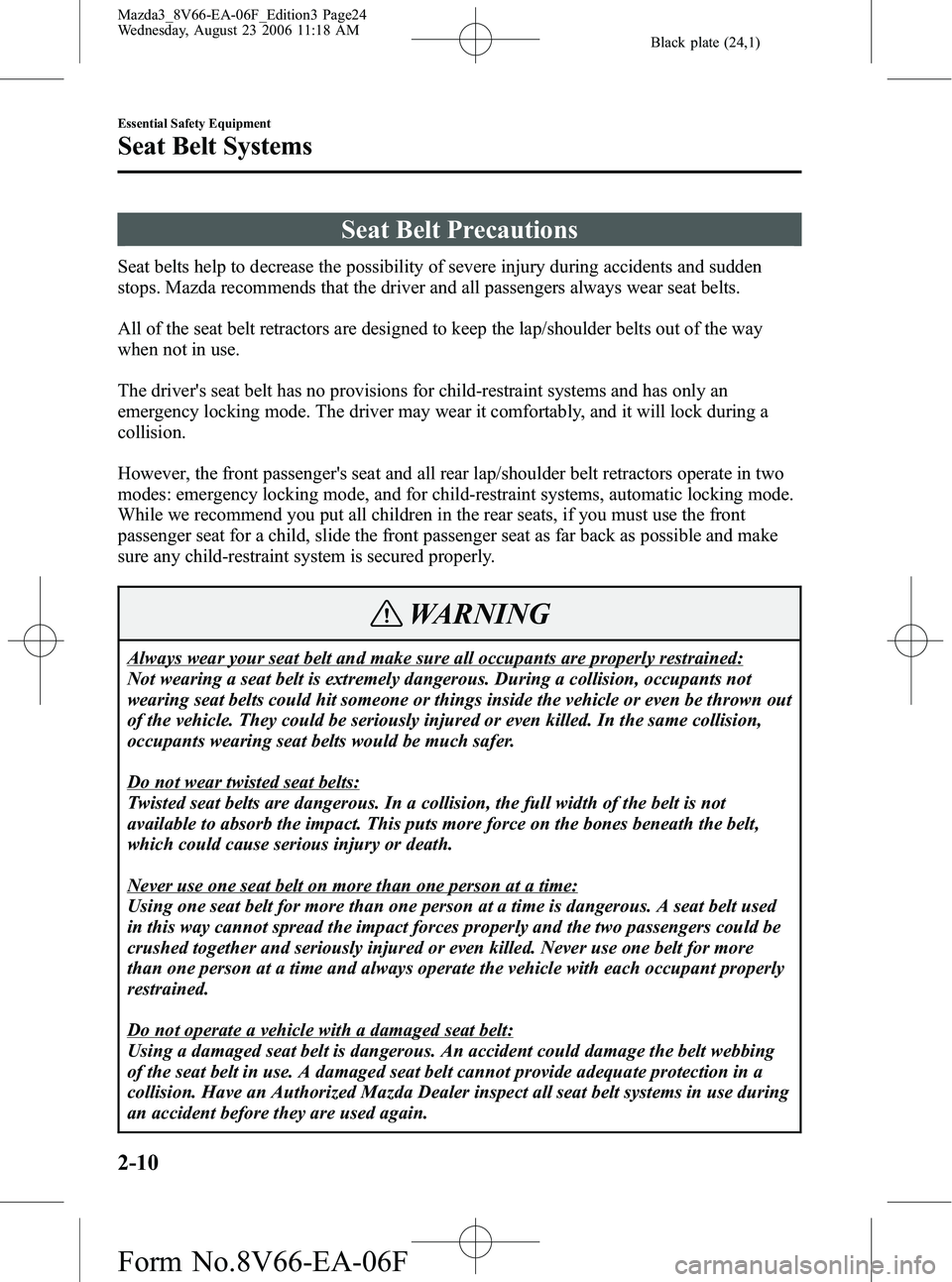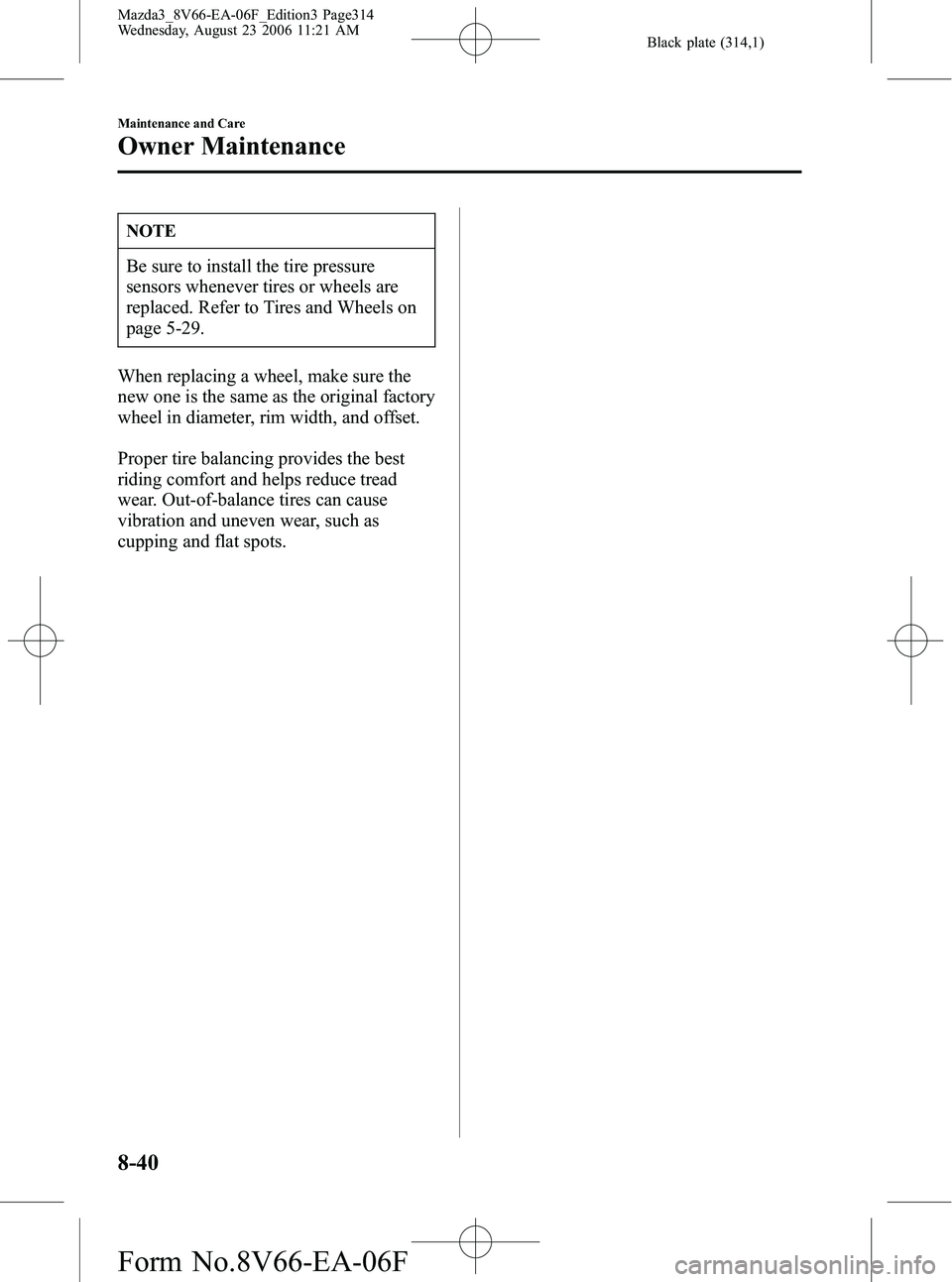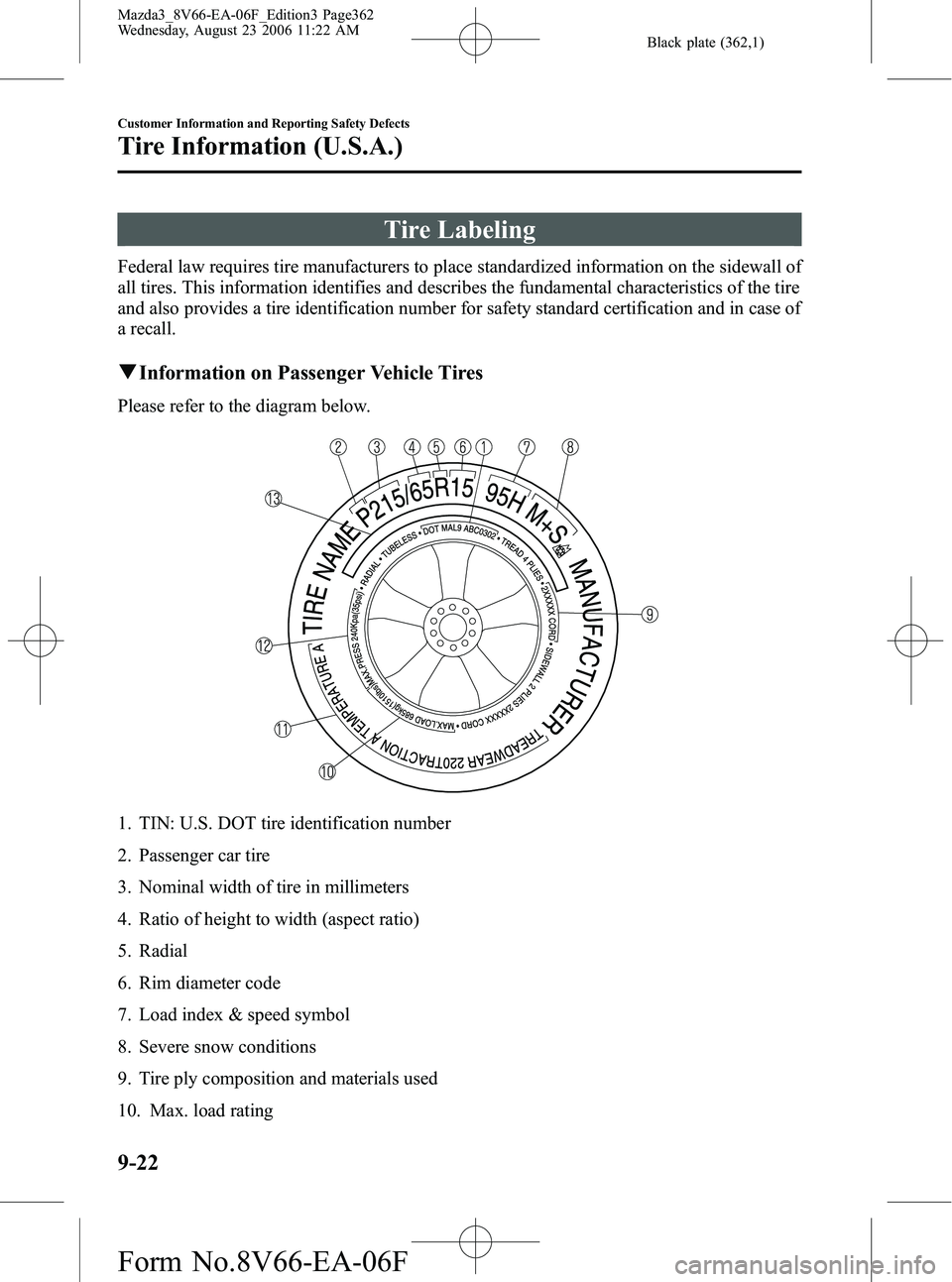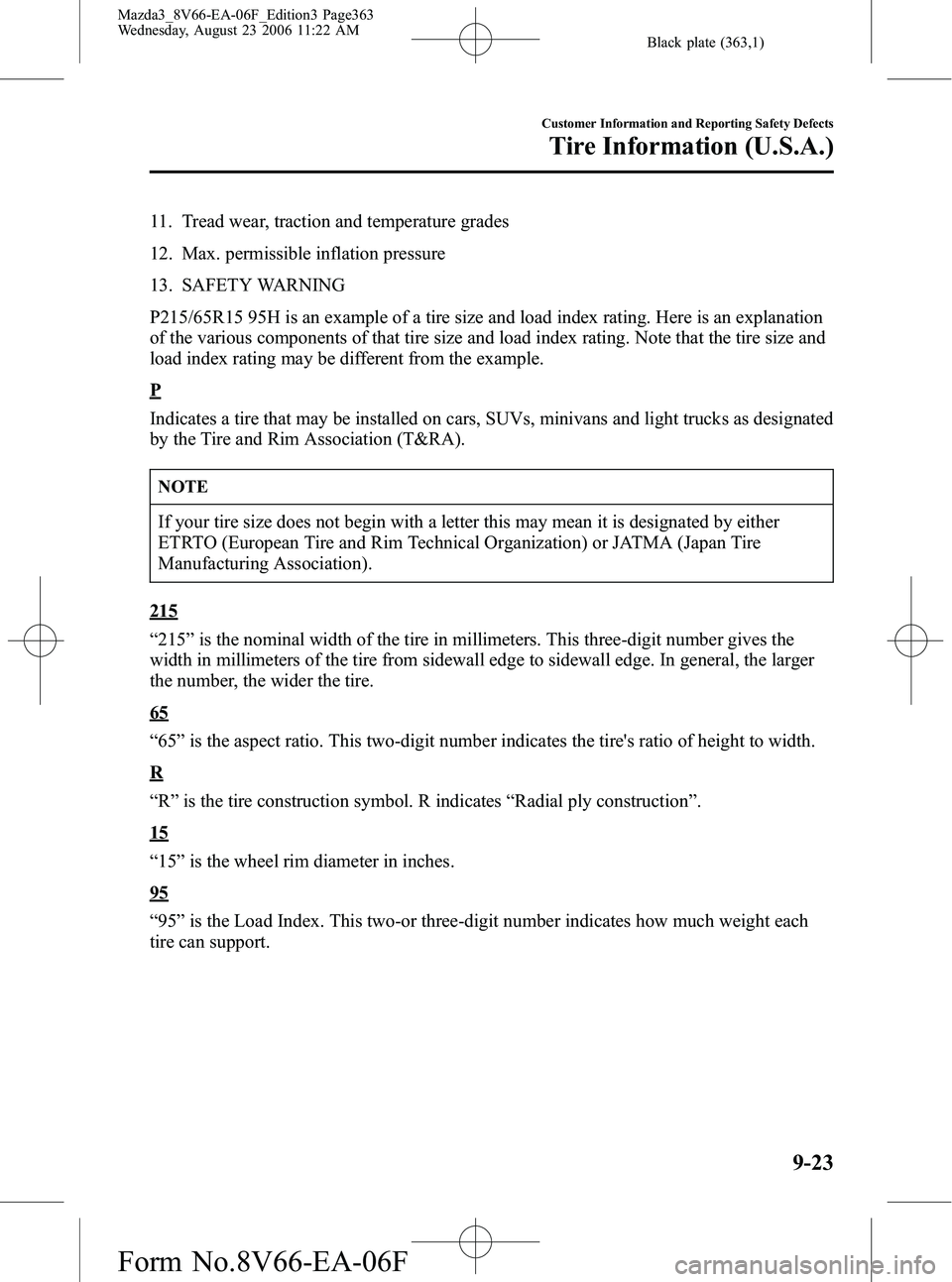width MAZDA MODEL 3 4-DOOR 2007 Owners Manual
[x] Cancel search | Manufacturer: MAZDA, Model Year: 2007, Model line: MODEL 3 4-DOOR, Model: MAZDA MODEL 3 4-DOOR 2007Pages: 402, PDF Size: 5.12 MB
Page 24 of 402

Black plate (24,1)
Seat Belt Precautions
Seat belts help to decrease the possibility of severe injury during accidents and sudden
stops. Mazda recommends that the driver and all passengers always wear seat belts.
All of the seat belt retractors are designed to keep the lap/shoulder belts out of the way
when not in use.
The driver's seat belt has no provisions for child-restraint systems and has only an
emergency locking mode. The driver may wear it comfortably, and it will lock during a
collision.
However, the front passenger's seat and all rear lap/shoulder belt retractors operate in two
modes: emergency locking mode, and for child-restraint systems, automatic locking mode.
While we recommend you put all children in the rear seats, if you must use the front
passenger seat for a child, slide the front passenger seat as far back as possible and make
sure any child-restraint system is secured properly.
WARNING
Always wear your seat belt and make sure all occupants are properly restrained:
Not wearing a seat belt is extremely dangerous. During a collision, occupants not
wearing seat belts could hit someone or things inside the vehicle or even be thrown out
of the vehicle. They could be seriously injured or even killed. In the same collision,
occupants wearing seat belts would be much safer.
Do not wear twisted seat belts:
Twisted seat belts are dangerous. In a collision, the full width of the belt is not
available to absorb the impact. This puts more force on the bones beneath the belt,
which could cause serious injury or death.
Never use one seat belt on more than one person at a time:
Using one seat belt for more than one person at a time is dangerous. A seat belt used
in this way cannot spread the impact forces properly and the two passengers could be
crushed together and seriously injured or even killed. Never use one belt for more
than one person at a time and always operate the vehicle with each occupant properly
restrained.
Do not operate a vehicle with a damaged seat belt:
Using a damaged seat belt is dangerous. An accident could damage the belt webbing
of the seat belt in use. A damaged seat belt cannot provide adequate protection in a
collision. Have an Authorized Mazda Dealer inspect all seat belt systems in use during
an accident before they are used again.
2-10
Essential Safety Equipment
Seat Belt Systems
Mazda3_8V66-EA-06F_Edition3 Page24
Wednesday, August 23 2006 11:18 AM
Form No.8V66-EA-06F
Page 314 of 402

Black plate (314,1)
NOTE
Be sure to install the tire pressure
sensors whenever tires or wheels are
replaced. Refer to Tires and Wheels on
page 5-29.
When replacing a wheel, make sure the
new one is the same as the original factory
wheel in diameter, rim width, and offset.
Proper tire balancing provides the best
riding comfort and helps reduce tread
wear. Out-of-balance tires can cause
vibration and uneven wear, such as
cupping and flat spots.
8-40
Maintenance and Care
Owner Maintenance
Mazda3_8V66-EA-06F_Edition3 Page314
Wednesday, August 23 2006 11:21 AM
Form No.8V66-EA-06F
Page 361 of 402

Black plate (361,1)
WARNING
The temperature grade for this tire is established for a tire that is properly inflated and
not overloaded. Excessive speed, underinflation, or excessive loading, either
separately or in combination, can cause heat buildup and possible tire failure.
These grades will be added to the sidewalls of passenger vehicle tires over the next several
years according to a schedule established by the NHTSA and the tire manufacturers.
The grade of tires available as standard or optional equipment on Mazda vehicles may vary
with respect to grade.
ALL PASSENGER VEHICLE TIRES MUST CONFORM TO THESE GRADES AND
TO ALL OTHER FEDERAL TIRE-SAFETY REQUIREMENTS.
q Uniform Tire Quality Grading
Quality grades can be found where applicable on the tire sidewall between tread shoulder
and maximum section width.
For example:
Treadwear 200 Traction AA Temperature A
TREADWEAR 200 TRACTION AA
TEMPERATURE A
UTQGS MARK (example)
Customer Information and Reporting Safety Defects
Uniform Tire Quality Grading System (UTQGS)
9-21
Mazda3_8V66-EA-06F_Edition3 Page361
Wednesday, August 23 2006 11:22 AM
Form No.8V66-EA-06F
Page 362 of 402

Black plate (362,1)
Tire Labeling
Federal law requires tire manufacturers to place standardized information on the sidewall of
all tires. This information identifies and describes the fundamental characteristics of the tire
and also provides a tire identification number for safety standard certification and in case of
a recall.
qInformation on Passenger Vehicle Tires
Please refer to the diagram below.
1. TIN: U.S. DOT tire identification number
2. Passenger car tire
3. Nominal width of tire in millimeters
4. Ratio of height to width (aspect ratio)
5. Radial
6. Rim diameter code
7. Load index & speed symbol
8. Severe snow conditions
9. Tire ply composition and materials used
10. Max. load rating
9-22
Customer Information and Reporting Safety Defects
Tire Information (U.S.A.)
Mazda3_8V66-EA-06F_Edition3 Page362
Wednesday, August 23 2006 11:22 AM
Form No.8V66-EA-06F
Page 363 of 402

Black plate (363,1)
11. Tread wear, traction and temperature grades
12. Max. permissible inflation pressure
13. SAFETY WARNING
P215/65R15 95H is an example of a tire size and load index rating. Here is an explanation
of the various components of that tire size and load index rating. Note that the tire size and
load index rating may be different from the example.
P
Indicates a tire that may be installed on cars, SUVs, minivans and light trucks as designated
by the Tire and Rim Association (T&RA).
NOTE
If your tire size does not begin with a letter this may mean it is designated by either
ETRTO (European Tire and Rim Technical Organization) or JATMA (Japan Tire
Manufacturing Association).
215
“215 ”is the nominal width of the tire in millimeters. This three-digit number gives the
width in millimeters of the tire from sidewall edge to sidewall edge. In general, the larger
the number, the wider the tire.
65
“ 65 ”is the aspect ratio. This two-digit number indicates the tire's ratio of height to width.
R
“R” is the tire construction symbol. R indicates “Radial ply construction ”.
15
“15 ”is the wheel rim diameter in inches.
95
“95 ”is the Load Index. This two-or three-digit number indicates how much weight each
tire can support.
Customer Information and Reporting Safety Defects
Tire Information (U.S.A.)
9-23
Mazda3_8V66-EA-06F_Edition3 Page363
Wednesday, August 23 2006 11:22 AM
Form No.8V66-EA-06F
Page 366 of 402

Black plate (366,1)
qInformation on Temporary Tires
Please refer to the diagram below.
1. Temporary tires
2. Nominal width of tire in millimeters
3. Ratio of height to width (aspect ratio)
4. Diagonal
5. Rim diameter code
6. Load index&speed symbol
T115/70D 16 90M is an example of a tire size and load index rating. Here is an explanation
of the various components of that tire size and load index rating. Note that the tire size and
load index rating may be different from the example.
T
Indicates a tire that may be installed on cars, SUVs, minivans and light trucks as designated
by the Tire and Rim Association (T&RA).
11 5
“115 ”is the nominal width of the tire in millimeters. This three-digit number gives the
width in millimeters of the tire from sidewall edge to sidewall edge. In general, the larger
the number, the wider the tire.
9-26
Customer Information and Reporting Safety Defects
Tire Information (U.S.A.)
Mazda3_8V66-EA-06F_Edition3 Page366
Wednesday, August 23 2006 11:22 AM
Form No.8V66-EA-06F
Page 367 of 402

Black plate (367,1)
70
“70 ”is the aspect ratio. This two-digit number indicates the tire's ratio of height to width.
D
“D ”is the tire construction symbol. D indicates “diagonal ply construction ”.
16
“16 ”is the wheel rim diameter in inches.
90
“90 ”is the Load Index. This two-or three-digit number indicates how much weight each
tire can support.
M
“ M ”is the speed rating. The speed rating denotes the maximum speed for which the use of
the tire is rated.
Letter Rating Speed Rating
M 81 mph
Customer Information and Reporting Safety Defects
Tire Information (U.S.A.)
9-27
Mazda3_8V66-EA-06F_Edition3 Page367
Wednesday, August 23 2006 11:22 AM
Form No.8V66-EA-06F
Page 390 of 402

Black plate (390,1)
qDimensions
Item Model
4 Door 5 Door
Overall length Without
turbocharger STANDARD TYPE 4,505 mm (177.4 in)
―
SPORTY TYPE 4,510 mm (177.6 in) 4,490 mm (176.8 in)
With turbocharger ―4,490 mm (176.8 in)
Overall width Without
turbocharger Without side molding 1,745 mm (68.7 in) 1,745 mm (68.7 in)
With side molding 1,755 mm (69.1 in) 1,755 mm (69.1 in)
With turbocharger ―1,765 mm (69.5 in)
Overall height 1,465 mm (57.7 in) 1,465 mm (57.7 in)
Front tread Without turbocharger 1,530 mm (60.2 in) 1,530 mm (60.2 in)
With turbocharger
―1,535 mm (60.4 in)
Rear tread Without turbocharger 1,515 mm (59.6 in) 1,515 mm (59.6 in)
With turbocharger
―1,525 mm (60.0 in)
Wheelbase 2,640 mm (103.9 in) 2,640 mm (103.9 in)
q Weights
4 Door
2.0-liter engine
Item Weight
Manual transaxle Automatic transaxle
GVWR (Gross Vehicle Weight Rating) 1,719 kg (3,790 lbs) 1,733 kg (3,821 lbs)
GAWR (Gross Axle Weight Rating) Front 919 kg (2,026 lbs) 983 kg (2,068 lbs)
Rear 800 kg (1,764 lbs) 795 kg (1,753 lbs)
2.3-liter engine
Item Weight
Manual transaxle Automatic transaxle
GVWR (Gross Vehicle Weight Rating) 1,764 kg (3,889 lbs) 1,792 kg (3,951 lbs)
GAWR (Gross Axle Weight Rating) Front 955 kg (2,105 lbs) 981 kg (2,163 lbs)
Rear 812 kg (1,790 lbs) 811 kg (1,788 lbs)
5 Door
Without turbocharger
Item Weight
Manual transaxle Automatic transaxle
GVWR (Gross Vehicle Weight Rating) 1,783 kg (3,931 lbs) 1,811 kg (3,993 lbs)
GAWR (Gross Axle Weight Rating) Front 957 kg (2,110 lbs) 983 kg (2,167 lbs)
Rear 829 kg (1,828 lbs) 828 kg (1,825 lbs)
10-6
Specifications
Mazda3_8V66-EA-06F_Edition3 Page390
Wednesday, August 23 2006 11:22 AM
Form No.8V66-EA-06F